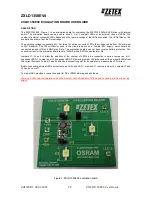
Chapter 2: Installation
2-3
Installation
2-3
Mounting the Motherboard in the Chassis
All motherboards have standard mounting holes to fit different types of chassis.
Chassis may include a variety of mounting fasteners made of metal or plastic.
Although a chassis may have both types, metal fasteners are the most highly
recommended because they ground the motherboard to the chassis. For this
reason, it is best to use as many metal fasteners as possible.
Figure 2-1. Universal Retention Mechanism (URM)
Arm (in upright
position)
With the heat sink facing toward the RIMM/DIMM memory slots, slide the
SEPP/SECC/SECC2 processor package into the URM and continue pushing it
down until fully seated in the Slot 1 connector. Some URMs have extra
caps to be used for SECC2 processors (AMP URMs do not have these). If
so, after the processor is installed in the motherboard, place a cap on each
end of the URM and push down until they snap into place. These caps are
not left/right specific.
*Note: The Pentium II processor comes in the SECC package, which has
locking tabs on the top corners. Before installing the Pentium II package into
the URM, push these two locks inward until you hear a click. (After you
have fully seated the processor into the Slot 1 connector as instructed
below, these locks should return to their outer positions.)
Summary of Contents for SUPER P6SWA
Page 1: ...SUPER P6SWA SUPER P6SWD USER S AND BIOS MANUAL Revision 1 3 SUPER...
Page 8: ...Notes SUPER P6SWA P6SWD Manual...
Page 11: ...Chapter 1 Introduction 1 3 Introduction Notes...
Page 12: ...SUPER P6SWA P6SWD Manual 1 4 Introduction SUPER P6SWA Figure 1 1 SUPER P6SWA Motherboard Image...
Page 13: ...Chapter 1 Introduction 1 5 Introduction SUPER P6SWD Figure 1 2 SUPER P6SWD Motherboard Image...
Page 28: ...SUPER P6SWA P6SWD Manual 1 20 Introduction Notes...
Page 44: ...2 16 SUPER P6SWA P6SWD Manual Installation Notes...















































